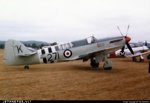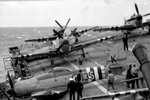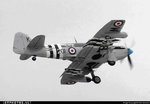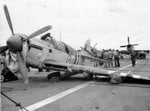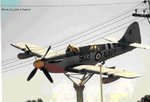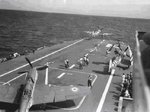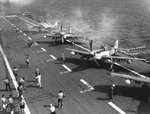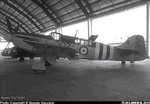parsifal
Colonel
My second build for this GB is intended to be a companion build for the Fury I have recently completed. Its a Fairey Firefly AS5 or 6 (they are virtually identical in appearance) from 817 Sqn, HMAS Sydney 1951-2.
Entry Details
Fairey Firefly Royal Australian Navy - My Favourite Aircraft Of All Time (well one of them)
User name: Parsifal
Name: Michael
Category: 1, Beginner
Kit: Special Hobby" Fairey Firefly AS5/6
Scale: 1/72.
Accessories: None at this stage
Some background of 817 Sqn in Korea
21st CAG began carrier qualifications aboard Sydney in April 1951. On 14 May, 817 Squadron were advised that they, along with 805 and 808 Squadrons, would form part of a new Sydney Carrier Air Group under the command of Commander (later Vice Admiral Sir) Mike Fell, RN, and deploy to Korea later that year. New pilots, many straight out of training, hurriedly converted to local operating procedures and the squadron's aircraft, Firefly AS.6s, had to be replaced temporarily with AS.5 aircraft borrowed from 816 Squadron and the Royal Navy. The reason for this was that the AS.6 model Firefly did not have any guns whereas the AS.5 did. The AS.5's guns were considered necessary for the types of operations that the Fireflies would be undertaking in Korea, a consideration which was subsequently proven to be correct. 817 Squadron departed for Korea aboard Sydney on 31 August 1951. Sydney arrived in Japan on 19 September and prepared for a handover from HMS Glory. According to most histories the aircraft of the Sydney CAG now bore black and white markings signifying that they were on operations with the United Nations (UN). However, as the following photographs show, there is at least one shot showing Furies carrying the Invasion Stripes and the fireflies embarked not having such markings. There is also a lot of confusion about where the fuselage numbers and roundels were placed relative to the stripes. I have one photo from the war memorial in Canberra, saying it was shot in 1954 (but still under UN control), of aircraft S/N 239 with no stripes. I am also still a little unsure of the actual placement of roundels and numbers over or next to the striping. I hope to have this issue sorted by the time I get to that point
Participating in Operation 'Strangle,' which was intended to cut enemy supply and communications to the front lines, Sydney shared patrol duties on Korea's west coast with RN and US Navy (USN) carriers as part of Task Force 95, United Nations Blockade and Escort Force. Seven patrols of roughly 13 days duration, including four days in transit to and from bases in Japan, were originally planned. Operations normally entailed ground attack including close air support for ground forces, armed reconnaissance, spotting for ships guns and anti-shipping strike missions. In addition, the CAG maintained a Combat Area Patrol (CAP) during daylight hours to protect Sydney in the event of an enemy air attack.
Sydney's CAG launched its first air strikes on 5 October 1951. It did not take long before the air group earned a reputation as being a proficient strike unit having carried out a number of very successful missions against rail and road bridge targets. Fireflies proved exceptional in this role, the patented wing design allowed slower attack speeds and ensured stable platforms for bomb and rocket attacks. Rail and road interdiction became the main role of the squadron throughout the Korean War and this often required the pilots to use low level attacks against heavily defended targets behind enemy lines. Anti-aircraft fire was particularly effective under these circumstances and several Fireflies were lost or damaged as a result. Anti-submarine patrols were also flown by 817 Squadron around the Sydney task group and spotting tasks were also conducted for ships involved in Naval Gunfire Support off the Korean coastline.
Just six days after flying its first sorties, on 11 October, Sydney's CAG achieved a light fleet carrier record of 89 sorties in one day conducting attacking raids and targeting sorties for USS New Jersey.
Aircraft engineers and maintenance crews also won much well deserved praise achieving remarkable serviceability and turn-around rates to keep the aircraft flying. Ordnance crews were also required to load armaments of up to 227 kg in all weather, day and night.
On 14 October, 817 Squadron's personnel were subjected to the full force of Typhoon Ruth. Battling an estimated force 12 sea at its height, and with waves up to 45 feet high crashing over her deck, Sydney rode out the storm at sea with 13 of her aircraft exposed on deck. It was hardly surprising that five of them were written off with at least one being washed over board. The carrier itself sustained damage and several of her personnel suffered minor injuries.
During flying operations on 25-26 October, three of Sydney's aircraft were shot down and a fourth badly damaged. One of these, a Firefly from 817 Squadron, piloted by SBLT Neil MacMillan and CPO Phillip Hancox was forced down in a frozen rice paddy 50 miles behind enemy lines. The two downed aviators resisted capture by enemy soldiers with the aid of an Owen sub-machine gun and a protective overhead umbrella provided by Sea Furies from Sydney and Meteor jet fighters from the Royal Australian Air Force's (RAAF) 77 Squadron. The two airmen were later rescued by Sydney's Dragonfly helicopter which had flown 172 kilometres to carry out the rescue at the limit of its endurance. It then recovered to Kimpo and returned to Sydney with its passengers the following day. The helicopter pilot, CPO Arlene 'Dick' Babbit, USN, was awarded the Commonwealth Distinguished Service Medal as well as the United States Navy Cross for his efforts that day, earning the distinction of being the only allied serviceman in Korea to receive the awards of two nations for the same action.
With the onset of the Korean winter, flying operations became increasingly difficult for both the aircrew and maintainers of 817 Squadron. The icy conditions and subzero temperature on Sydney's windswept, and at times, snow covered flight deck resulted in a number of cases of frostbite and introduced the additional hazard of aircrew freezing to death if an aircraft was forced to ditch at sea.
Sydney's last raids were scheduled for 25 January 1952, striking directly on the North Korean capital of Pyongyang. Extremely poor weather, however, caused the mission to be cancelled and Sydney returned to Australia a few days later via Sasebo and Hong Kong.
Collectively, Sydney's CAG had flown 2366 sorties for the loss of three lives (all from 805 Squadron) and 14 aircraft (five of which were lost overboard or damaged beyond repair by Cyclone Ruth). Sydney had achieved an enviable operational record in Korea and it was noted that enemy activity decreased significantly in Sydney's area of operations.
The Kit is the Special hobby AS5 which i have only just received from England. I also have an airfix kit, which i pland to build outside the competition with the wings folded. i chose the Special hobby kit because it has cockpit details and far superior canopy
Entry Details
Fairey Firefly Royal Australian Navy - My Favourite Aircraft Of All Time (well one of them)
User name: Parsifal
Name: Michael
Category: 1, Beginner
Kit: Special Hobby" Fairey Firefly AS5/6
Scale: 1/72.
Accessories: None at this stage
Some background of 817 Sqn in Korea
21st CAG began carrier qualifications aboard Sydney in April 1951. On 14 May, 817 Squadron were advised that they, along with 805 and 808 Squadrons, would form part of a new Sydney Carrier Air Group under the command of Commander (later Vice Admiral Sir) Mike Fell, RN, and deploy to Korea later that year. New pilots, many straight out of training, hurriedly converted to local operating procedures and the squadron's aircraft, Firefly AS.6s, had to be replaced temporarily with AS.5 aircraft borrowed from 816 Squadron and the Royal Navy. The reason for this was that the AS.6 model Firefly did not have any guns whereas the AS.5 did. The AS.5's guns were considered necessary for the types of operations that the Fireflies would be undertaking in Korea, a consideration which was subsequently proven to be correct. 817 Squadron departed for Korea aboard Sydney on 31 August 1951. Sydney arrived in Japan on 19 September and prepared for a handover from HMS Glory. According to most histories the aircraft of the Sydney CAG now bore black and white markings signifying that they were on operations with the United Nations (UN). However, as the following photographs show, there is at least one shot showing Furies carrying the Invasion Stripes and the fireflies embarked not having such markings. There is also a lot of confusion about where the fuselage numbers and roundels were placed relative to the stripes. I have one photo from the war memorial in Canberra, saying it was shot in 1954 (but still under UN control), of aircraft S/N 239 with no stripes. I am also still a little unsure of the actual placement of roundels and numbers over or next to the striping. I hope to have this issue sorted by the time I get to that point
Participating in Operation 'Strangle,' which was intended to cut enemy supply and communications to the front lines, Sydney shared patrol duties on Korea's west coast with RN and US Navy (USN) carriers as part of Task Force 95, United Nations Blockade and Escort Force. Seven patrols of roughly 13 days duration, including four days in transit to and from bases in Japan, were originally planned. Operations normally entailed ground attack including close air support for ground forces, armed reconnaissance, spotting for ships guns and anti-shipping strike missions. In addition, the CAG maintained a Combat Area Patrol (CAP) during daylight hours to protect Sydney in the event of an enemy air attack.
Sydney's CAG launched its first air strikes on 5 October 1951. It did not take long before the air group earned a reputation as being a proficient strike unit having carried out a number of very successful missions against rail and road bridge targets. Fireflies proved exceptional in this role, the patented wing design allowed slower attack speeds and ensured stable platforms for bomb and rocket attacks. Rail and road interdiction became the main role of the squadron throughout the Korean War and this often required the pilots to use low level attacks against heavily defended targets behind enemy lines. Anti-aircraft fire was particularly effective under these circumstances and several Fireflies were lost or damaged as a result. Anti-submarine patrols were also flown by 817 Squadron around the Sydney task group and spotting tasks were also conducted for ships involved in Naval Gunfire Support off the Korean coastline.
Just six days after flying its first sorties, on 11 October, Sydney's CAG achieved a light fleet carrier record of 89 sorties in one day conducting attacking raids and targeting sorties for USS New Jersey.
Aircraft engineers and maintenance crews also won much well deserved praise achieving remarkable serviceability and turn-around rates to keep the aircraft flying. Ordnance crews were also required to load armaments of up to 227 kg in all weather, day and night.
On 14 October, 817 Squadron's personnel were subjected to the full force of Typhoon Ruth. Battling an estimated force 12 sea at its height, and with waves up to 45 feet high crashing over her deck, Sydney rode out the storm at sea with 13 of her aircraft exposed on deck. It was hardly surprising that five of them were written off with at least one being washed over board. The carrier itself sustained damage and several of her personnel suffered minor injuries.
During flying operations on 25-26 October, three of Sydney's aircraft were shot down and a fourth badly damaged. One of these, a Firefly from 817 Squadron, piloted by SBLT Neil MacMillan and CPO Phillip Hancox was forced down in a frozen rice paddy 50 miles behind enemy lines. The two downed aviators resisted capture by enemy soldiers with the aid of an Owen sub-machine gun and a protective overhead umbrella provided by Sea Furies from Sydney and Meteor jet fighters from the Royal Australian Air Force's (RAAF) 77 Squadron. The two airmen were later rescued by Sydney's Dragonfly helicopter which had flown 172 kilometres to carry out the rescue at the limit of its endurance. It then recovered to Kimpo and returned to Sydney with its passengers the following day. The helicopter pilot, CPO Arlene 'Dick' Babbit, USN, was awarded the Commonwealth Distinguished Service Medal as well as the United States Navy Cross for his efforts that day, earning the distinction of being the only allied serviceman in Korea to receive the awards of two nations for the same action.
With the onset of the Korean winter, flying operations became increasingly difficult for both the aircrew and maintainers of 817 Squadron. The icy conditions and subzero temperature on Sydney's windswept, and at times, snow covered flight deck resulted in a number of cases of frostbite and introduced the additional hazard of aircrew freezing to death if an aircraft was forced to ditch at sea.
Sydney's last raids were scheduled for 25 January 1952, striking directly on the North Korean capital of Pyongyang. Extremely poor weather, however, caused the mission to be cancelled and Sydney returned to Australia a few days later via Sasebo and Hong Kong.
Collectively, Sydney's CAG had flown 2366 sorties for the loss of three lives (all from 805 Squadron) and 14 aircraft (five of which were lost overboard or damaged beyond repair by Cyclone Ruth). Sydney had achieved an enviable operational record in Korea and it was noted that enemy activity decreased significantly in Sydney's area of operations.
The Kit is the Special hobby AS5 which i have only just received from England. I also have an airfix kit, which i pland to build outside the competition with the wings folded. i chose the Special hobby kit because it has cockpit details and far superior canopy
Last edited by a moderator:

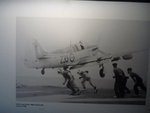
![000_0137[1].jpg](/forum/data/attachments/176/176940-c6b17aeb287b2b4923a1c0372303874f.jpg)
![000_0181[1].jpg](/forum/data/attachments/176/176941-1bf2b7c5e4f74169c9455610536d472c.jpg)
